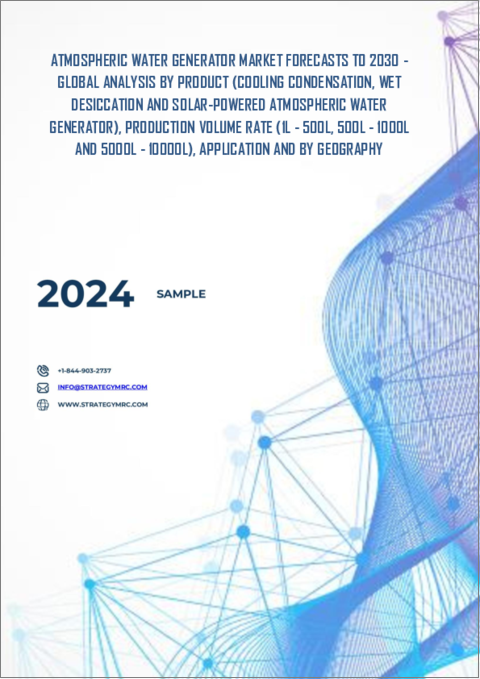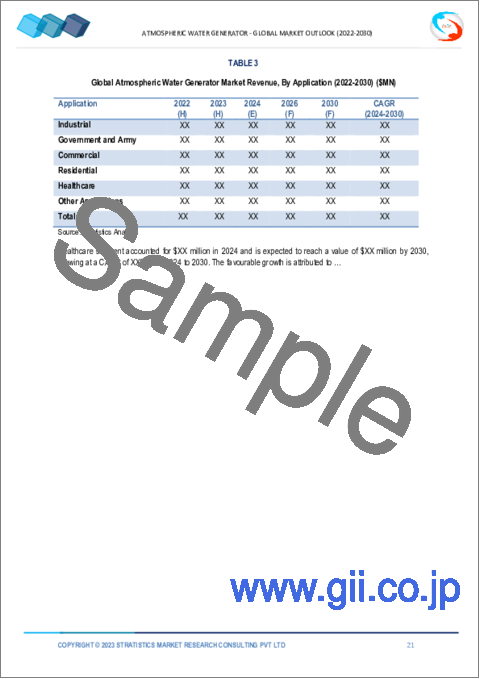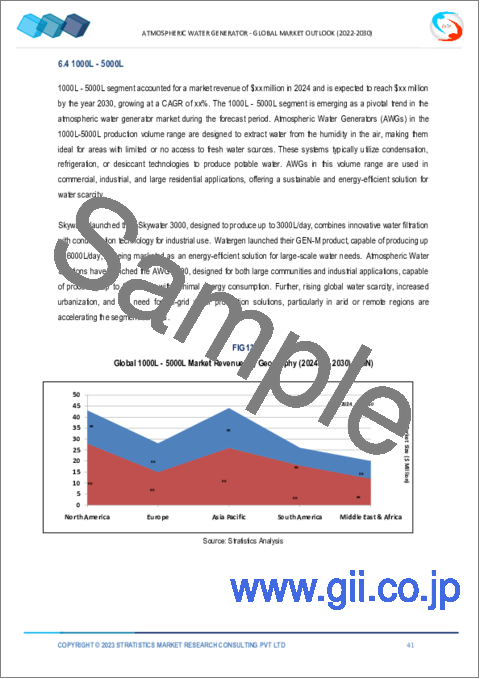|
|
市場調査レポート
商品コード
1494871
大気水生成装置(AWG)の2030年までの市場予測:製品別、生産量別、用途別、地域別の世界分析Atmospheric Water Generator Market Forecasts to 2030 - Global Analysis By Product, Production Volume Rate, Application and By Geography |
||||||
カスタマイズ可能
|
|||||||
| 大気水生成装置(AWG)の2030年までの市場予測:製品別、生産量別、用途別、地域別の世界分析 |
|
出版日: 2024年06月06日
発行: Stratistics Market Research Consulting
ページ情報: 英文 200+ Pages
納期: 2~3営業日
|
全表示
- 概要
- 図表
- 目次
Stratistics MRCによると、世界の大気水生成装置(AWG)市場は2024年に30億米ドルを占め、予測期間中にCAGR 18.4%で成長し、2030年には82億8,000万米ドルに達すると予測されています。
大気圧水生成は、大気から様々な純度の水を得る技術です。大気圧水生成装置では、空気を露点以下に冷却するか、空気を乾燥剤にさらすか、空気を加圧することによって、空気中の水蒸気を凝縮させる。大気圧水生成装置を使えば、かなりの量の水を抽出することができるが、大気圧水の抽出にまったくコストがかからないわけではないです。
ユニセフによれば、世界人口のほぼ3分の2が、毎年少なくとも1ヶ月は水不足に直面しています。世界保健機関(WHO)によると、2050年までに世界人口の半数以上が水不足の地域に住むと予測されています。
深刻化する水不足
工業化の進展、人口の増加、社会経済の発展に伴い、水の消費量は世界中で劇的に増加しています。国連の世界水資源開発によると、水の消費量は現在の使用量に比べて20~30%増加すると予想されています。こうした要因は、淡水資源に不必要なストレスを与える原因となっています。空気から水への変換は、湿度の高い空気から水を抽出する実証済みの技術です。そのため、これらのシステムは清潔な水の並行供給源として広く設置されています。したがって、水需要の増加と不足に伴い、この市場の需要は増加しています。
高コスト
製品コストの高さは、特に家庭用および軽商業用アプリケーションにおいて、市場の成長を抑制する要因のひとつです。さらに、これらのシステムは大量の電力を消費し、効率的に作動させるには継続的な供給が必要です。その結果、運転にかかる総コストが増大します。
斬新な技術開発
水生成の効率改善と設備コストの削減を中心とした絶え間ない調査活動は、世界的にその採用に影響を与えています。研究開発の結果、高度なろ過システム、電気的に改善された採水、高度な酸化プロセス、自動可変ろ過技術などの新技術が開発されました。これらの新技術は、節水を支援する独自のメカニズムを構築することによって、世界市場シェアにおける地位を確立するために、メーカーによって様々な製品に組み込まれています。
代替技術との競合
海水淡水化、雨水利用、高度浄水システムなどの技術は、水不足に対してより費用対効果が高く、確立された解決策を提供することが多いです。例えば、海水淡水化は沿岸地域で非常に効果的であり、雨水利用はより簡単でエネルギー消費量も少ないです。こうした代替手段は、特に大気圧水生成装置がすでに広く使用されている地域では、大気圧水生成装置の採用を制限する可能性があり、市場成長の課題となっています。
COVID-19の影響:
COVID-19パンデミックは大気水生成装置(AWG)(AWG)市場に大きな影響を与えました。世界のサプライチェーンの混乱により、AWGシステムの製造と納入に遅れが生じました。しかし、パンデミックの間、健康と衛生への重点が高まったことで、清潔で安全な飲料水ソリューションへの需要が高まり、AWGへの関心が高まった。さらに、遠隔地での作業動向やロックダウンは、水供給における自給自足の重要性を強調し、市場の成長をさらに促進しました。
予測期間中、湿式乾燥分野が最大となる見込み
大気圧水生成装置(AWG)市場における湿式乾燥分野は、多様な気候条件下での効率的な水抽出能力により、顕著な成長を遂げています。この技術は、吸湿性材料を活用して空気中の水分を吸収し、それを抽出して凝縮させて液体の水にします。他のAWG方式に比べ低湿度環境でも有効なため、乾燥した気候の地域には特に魅力的です。さらに、材料科学とエネルギー効率の進歩が運転コストを下げ、その採用をさらに後押ししています。
予測期間中、住宅分野が最も高いCAGRが見込まれる
大気水生成装置(AWG)市場の住宅セグメントは、水不足に対する意識の高まりと持続可能な水ソリューションの必要性から大きな成長を遂げています。特に淡水へのアクセスが限られている地域では、信頼性の高い独立した清潔な飲料水源を確保するためにAWGを採用する住宅所有者が増えています。さらに、健康とウェルネスを重視する消費者の高まりは、自治体の水道水にしばしば見られる汚染物質を避けるために、こうした機器への投資を促しています。環境問題への関心と、ボトル入り飲料水から出るプラスチック廃棄物を減らしたいという願望も、住宅市場での需要増加に寄与しています。
最大のシェアを占める地域:
アジア太平洋地域が最も高い市場シェアを占めると予測されるのは、生物学的汚染や低ミネラル化の心配がない純水に対する需要の増加や、中国やインドといった著名な国々における消費者意識の高まりによるものです。これは、アジア諸国が水の主要消費国であり、中国がそれに続くからです。東南アジア諸国では水不足が急速に深刻化しているため、水を生成する発電機が人気を集めています。さらに、アジア太平洋では、人口増加に比べて飲料水が十分に行き渡っていないです。こうした要因は、アジア太平洋市場に有利な機会を生み出すと期待されています。
CAGRが最も高い地域:
中東・アフリカが最もCAGRが高いと予測されます。中東・アフリカ諸国は、異常気象による水不足に直面しています。これらの地域は、毎日の水需要を満たすために水ボトルや海水淡水化プラントに大きく依存しています。空気から水へのシステムは、飲料水を生産するより経済的な方法を提供します。それゆえ、これらのシステムは急速に地方で採用されています。さらに、GCCは市場の成長に大きく貢献しており、予測期間中も主導的地位を維持すると予想されます。
無料のカスタマイズ提供:
本レポートをご購読のお客様には、以下の無料カスタマイズオプションのいずれかをご利用いただけます:
- 企業プロファイル
- 追加市場プレイヤーの包括的プロファイリング(3社まで)
- 主要企業のSWOT分析(3社まで)
- 地域セグメンテーション
- 顧客の関心に応じた主要国の市場推計・予測・CAGR(注:フィージビリティチェックによる)
- 競合ベンチマーキング
- 製品ポートフォリオ、地理的プレゼンス、戦略的提携に基づく主要企業のベンチマーキング
目次
第1章 エグゼクティブサマリー
第2章 序文
- 概要
- ステークホルダー
- 調査範囲
- 調査手法
- データマイニング
- データ分析
- データ検証
- 調査アプローチ
- 調査情報源
- 1次調査情報源
- 2次調査情報源
- 前提条件
第3章 市場動向分析
- 促進要因
- 抑制要因
- 機会
- 脅威
- 製品分析
- 用途分析
- 新興市場
- COVID-19の影響
第4章 ポーターのファイブフォース分析
- 供給企業の交渉力
- 買い手の交渉力
- 代替品の脅威
- 新規参入業者の脅威
- 競争企業間の敵対関係
第5章 世界の大気水生成装置(AWG)市場:製品別
- 冷却結露
- 圧力凝縮
- 併用技術
- 冷凍凝縮
- 湿潤乾燥
- 濾過
- 水出力
- 空気取り入れ口
- 塩水循環
- 塩水
- 料金
- 安全性
- 腐食
- 濾過
- 太陽光発電による大気水生成装置(AWG)
第6章 世界の大気水生成装置(AWG)市場:生産量別
- 1L-500L
- 500L-1000L
- 1000L-5000L
- 5000L-10000L
第7章 世界の大気水生成装置(AWG)市場:用途別
- 産業
- 農業
- 石油ガス
- 政府と軍隊
- 商業
- 住宅
- ヘルスケア
- その他の用途
第8章 世界の大気水生成装置(AWG)市場:地域別
- 北米
- 米国
- カナダ
- メキシコ
- 欧州
- ドイツ
- 英国
- イタリア
- フランス
- スペイン
- その他欧州
- アジア太平洋地域
- 日本
- 中国
- インド
- オーストラリア
- ニュージーランド
- 韓国
- その他アジア太平洋地域
- 南米
- アルゼンチン
- ブラジル
- チリ
- その他南米
- 中東・アフリカ
- サウジアラビア
- アラブ首長国連邦
- カタール
- 南アフリカ
- その他中東とアフリカ
第9章 主な発展
- 契約、パートナーシップ、コラボレーション、合弁事業
- 買収と合併
- 新製品発売
- 事業拡大
- その他の主要戦略
第10章 企業プロファイリング
- Air2Water LLC
- AirOWater Pvt Ltd
- Akvo Atmospheric Water Systems Pvt Ltd
- Atlantis Solar
- Atmospheric Water Solutions, Inc
- Bharat Electronics Ltd
- Cirrus Water
- Dew Point Manufacturing
- Drinkable Air, Inc
- Element Four Technologies, Inc
- Energy and Water Development Corp(EAWD)
- Majik Water
- Planets Water Corp
- Quest Water Solutions
- SkyH2O, Inc
- Skywell, LLC
- Sun-To-Water Technologies, LLC
- Veragon Water Solutions Ltd
- Water Harvesting Solutions, Inc
- Watergen Ltd
- World Environmental Solutions Pty Ltd
- Yueqing Kemao Electric Co Ltd
List of Tables
- Table 1 Global Atmospheric Water Generator Market Outlook, By Region (2022-2030) ($MN)
- Table 2 Global Atmospheric Water Generator Market Outlook, By Product (2022-2030) ($MN)
- Table 3 Global Atmospheric Water Generator Market Outlook, By Cooling Condensation (2022-2030) ($MN)
- Table 4 Global Atmospheric Water Generator Market Outlook, By Pressure Condensing (2022-2030) ($MN)
- Table 5 Global Atmospheric Water Generator Market Outlook, By Combination Technique (2022-2030) ($MN)
- Table 6 Global Atmospheric Water Generator Market Outlook, By Refrigeration Condensing (2022-2030) ($MN)
- Table 7 Global Atmospheric Water Generator Market Outlook, By Wet Desiccation (2022-2030) ($MN)
- Table 8 Global Atmospheric Water Generator Market Outlook, By Filtration (2022-2030) ($MN)
- Table 9 Global Atmospheric Water Generator Market Outlook, By Water output (2022-2030) ($MN)
- Table 10 Global Atmospheric Water Generator Market Outlook, By Air intake (2022-2030) ($MN)
- Table 11 Global Atmospheric Water Generator Market Outlook, By Brine circulation (2022-2030) ($MN)
- Table 12 Global Atmospheric Water Generator Market Outlook, By Brine (2022-2030) ($MN)
- Table 13 Global Atmospheric Water Generator Market Outlook, By Cost (2022-2030) ($MN)
- Table 14 Global Atmospheric Water Generator Market Outlook, By Safety (2022-2030) ($MN)
- Table 15 Global Atmospheric Water Generator Market Outlook, By Corrosion (2022-2030) ($MN)
- Table 16 Global Atmospheric Water Generator Market Outlook, By Solar-Powered Atmospheric Water Generator (2022-2030) ($MN)
- Table 17 Global Atmospheric Water Generator Market Outlook, By Production Volume Rate (2022-2030) ($MN)
- Table 18 Global Atmospheric Water Generator Market Outlook, By 1L - 500L (2022-2030) ($MN)
- Table 19 Global Atmospheric Water Generator Market Outlook, By 500L - 1000L (2022-2030) ($MN)
- Table 20 Global Atmospheric Water Generator Market Outlook, By 1000L - 5000L (2022-2030) ($MN)
- Table 21 Global Atmospheric Water Generator Market Outlook, By 5000L - 10000L (2022-2030) ($MN)
- Table 22 Global Atmospheric Water Generator Market Outlook, By Application (2022-2030) ($MN)
- Table 23 Global Atmospheric Water Generator Market Outlook, By Industrial (2022-2030) ($MN)
- Table 24 Global Atmospheric Water Generator Market Outlook, By Agriculture (2022-2030) ($MN)
- Table 25 Global Atmospheric Water Generator Market Outlook, By Oil & Gas (2022-2030) ($MN)
- Table 26 Global Atmospheric Water Generator Market Outlook, By Government and Army (2022-2030) ($MN)
- Table 27 Global Atmospheric Water Generator Market Outlook, By Commercial (2022-2030) ($MN)
- Table 28 Global Atmospheric Water Generator Market Outlook, By Residential (2022-2030) ($MN)
- Table 29 Global Atmospheric Water Generator Market Outlook, By Healthcare (2022-2030) ($MN)
- Table 30 Global Atmospheric Water Generator Market Outlook, By Other Applications (2022-2030) ($MN)
Note: Tables for North America, Europe, APAC, South America, and Middle East & Africa Regions are also represented in the same manner as above.
According to Stratistics MRC, the Global Atmospheric Water Generator Market is accounted for $3.00 billion in 2024 and is expected to reach $8.28 billion by 2030 growing at a CAGR of 18.4% during the forecast period. Atmospheric water generation is the technique of obtaining water of a variety of purity grades from the atmosphere. In atmospheric water generator, water vapour in the air is condensed either by cooling the air below its dew point, by exposing the air to desiccants, or by pressurizing the air. Though using atmospheric water generator, a considerable amount of water can be extracted, the extraction of atmospheric water may not be entirely free of cost.
According to UNICEF, almost two-thirds of the world's population faces water shortages for at least one month each year. According to the World Health Organization, by 2050, more than half of the world's population is projected to reside in water-stressed areas.
Market Dynamics:
Driver:
Growing Water Scarcity
With increasing industrialization activities, growing population and rising socio-economic developments, the consumption of water has been increased dramatically around the world. According to the United Nations World Water Development, water consumption is expected to increase by 20 to 30% as compared to current water use. Such factors are responsible for unnecessary stress on freshwater resources. Air to water is a proven technology to extract water from humid air. Therefore, these systems are widely installed as a parallel source for clean water. Hence, with the increase in water demand and scarcity, the demand for this market is increasing.
Restraint:
High Cost
High product cost is one of the factors restraining the growth of the market, especially in household and light commercial applications. Moreover, these systems consume a significant amount of electricity and require continuous supply to operate efficiently. This, in turn, increases the overall cost of the operation.
Opportunity:
Novel Technology Developments
The uninterrupted research operations centering on the improvement regarding the efficiency of water generation and equipment cost reduction are influencing the adoption of it, globally. The research studies have resulted in the development of some new technologies including advanced filtration systems, electrically improved harvesting, advanced oxidation processes, and automatic variable filtration technology. These novel technologies are being integrated within varied of its offerings by manufacturers to mark their position in the global market share by creating a unique mechanism to help conserve water.
Threat:
Competition From Alternative Technologies
Technologies such as desalination, rainwater harvesting, and advanced water filtration systems often offer more cost-effective and established solutions for water scarcity. Desalination, for instance, is highly effective in coastal areas, while rainwater harvesting is simpler and less energy-intensive. These alternatives can limit the adoption of atmospheric water generators, particularly in regions where they are already in widespread use, posing a challenge for market growth.
Covid-19 Impact:
The COVID-19 pandemic significantly impacted the Atmospheric Water Generator (AWG) market. Disruptions in the global supply chain led to delays in the manufacturing and delivery of AWG systems. However, the increased emphasis on health and hygiene during the pandemic heightened the demand for clean and safe drinking water solutions, boosting interest in AWGs. Additionally, the remote work trend and lockdowns underscored the importance of self-sufficiency in water supply, further driving market growth.
The wet desiccation segment is expected to be the largest during the forecast period
The wet desiccation segment in the Atmospheric Water Generator (AWG) market is experiencing notable growth due to its efficient water extraction capabilities in diverse climatic conditions. This technology leverages hygroscopic materials to absorb moisture from the air, which is then extracted and condensed into liquid water. Its effectiveness in low-humidity environments, compared to other AWG methods, makes it particularly appealing for regions with arid climates. Additionally, advancements in materials science and energy efficiency are driving down operational costs, further boosting its adoption.
The residential segment is expected to have the highest CAGR during the forecast period
The residential segment of the Atmospheric Water Generator (AWG) market is experiencing significant growth due to increasing awareness of water scarcity and the need for sustainable water solutions. Homeowners are increasingly adopting AWGs to ensure a reliable and independent source of clean drinking water, particularly in areas with limited access to fresh water. Additionally, the growing emphasis on health and wellness is encouraging consumers to invest in these devices to avoid contaminants often found in municipal water supplies. Environmental concerns and the desire to reduce plastic waste from bottled water are also contributing to the rising demand in the residential market.
Region with largest share:
The Asia Pacific is projected to hold the highest market share, owing to the increasing demand for pure water which is free from biological contamination and low mineralization, and a rise in consumer awareness in eminent countries such as China and India. This is because the Asian countries are the prime consumers of it, followed by China. Owing to the fastest increasing water scarcity in Southeast Asian countries, these generators are gaining popularity for producing water. Moreover, in Asia Pacific potable water is not sufficiently distributed as compared to its growing population. Such factors are expected to create lucrative opportunities for the market in the Asia Pacific.
Region with highest CAGR:
Middle East & Africa is projected to have the highest CAGR. The Middle East and African countries have been facing water scarcity due to extreme weather conditions. These regions are heavily dependent on water bottles & desalination plants to meet their daily water requirements. Air to water system provides a more economical way to produce potable water. Hence, these systems are rapidly adopted in the province. Furthermore, GCC is a key contributor to the growth of the market and is expected to maintain its leading position during the forecast period.
Key players in the market
Some of the key players in Atmospheric Water Generator market include Air2Water LLC, AirOWater Pvt Ltd, Akvo Atmospheric Water Systems Pvt Ltd, Atlantis Solar, Atmospheric Water Solutions, Inc, Bharat Electronics Ltd, Cirrus Water, Dew Point Manufacturing, Drinkable Air, Inc, Element Four Technologies, Inc, Energy and Water Development Corp (EAWD), Majik Water, Planets Water Corp, Quest Water Solutions, SkyH2O, Inc, Skywell, LLC, Sun-To-Water Technologies, LLC, Veragon Water Solutions Ltd, Water Harvesting Solutions, Inc, Watergen Ltd, World Environmental Solutions Pty Ltd and Yueqing Kemao Electric Co Ltd.
Key Developments:
In February 2024, SkyWater Technology has signed a production agreement with Nautilus Biotechnology to supply silicon-based microfluidic bio chips for Nautilus' proteome analysis system. This announcement is a significant milestone for SkyWater as Nautilus transitions from its Advanced Technology Services (ATS) custom development program to SkyWater's Wafer Services program.
Products Covered:
- Cooling Condensation
- Wet Desiccation
- Solar-Powered Atmospheric Water Generator
Production Volume Rates Covered:
- 1L - 500L
- 500L - 1000L
- 1000L - 5000L
- 5000L - 10000L
Applications Covered:
- Industrial
- Government and Army
- Commercial
- Residential
- Healthcare
- Other Applications
Regions Covered:
- North America
- US
- Canada
- Mexico
- Europe
- Germany
- UK
- Italy
- France
- Spain
- Rest of Europe
- Asia Pacific
- Japan
- China
- India
- Australia
- New Zealand
- South Korea
- Rest of Asia Pacific
- South America
- Argentina
- Brazil
- Chile
- Rest of South America
- Middle East & Africa
- Saudi Arabia
- UAE
- Qatar
- South Africa
- Rest of Middle East & Africa
What our report offers:
- Market share assessments for the regional and country-level segments
- Strategic recommendations for the new entrants
- Covers Market data for the years 2022, 2023, 2024, 2026, and 2030
- Market Trends (Drivers, Constraints, Opportunities, Threats, Challenges, Investment Opportunities, and recommendations)
- Strategic recommendations in key business segments based on the market estimations
- Competitive landscaping mapping the key common trends
- Company profiling with detailed strategies, financials, and recent developments
- Supply chain trends mapping the latest technological advancements
Free Customization Offerings:
All the customers of this report will be entitled to receive one of the following free customization options:
- Company Profiling
- Comprehensive profiling of additional market players (up to 3)
- SWOT Analysis of key players (up to 3)
- Regional Segmentation
- Market estimations, Forecasts and CAGR of any prominent country as per the client's interest (Note: Depends on feasibility check)
- Competitive Benchmarking
- Benchmarking of key players based on product portfolio, geographical presence, and strategic alliances
Table of Contents
1 Executive Summary
2 Preface
- 2.1 Abstract
- 2.2 Stake Holders
- 2.3 Research Scope
- 2.4 Research Methodology
- 2.4.1 Data Mining
- 2.4.2 Data Analysis
- 2.4.3 Data Validation
- 2.4.4 Research Approach
- 2.5 Research Sources
- 2.5.1 Primary Research Sources
- 2.5.2 Secondary Research Sources
- 2.5.3 Assumptions
3 Market Trend Analysis
- 3.1 Introduction
- 3.2 Drivers
- 3.3 Restraints
- 3.4 Opportunities
- 3.5 Threats
- 3.6 Product Analysis
- 3.7 Application Analysis
- 3.8 Emerging Markets
- 3.9 Impact of Covid-19
4 Porters Five Force Analysis
- 4.1 Bargaining power of suppliers
- 4.2 Bargaining power of buyers
- 4.3 Threat of substitutes
- 4.4 Threat of new entrants
- 4.5 Competitive rivalry
5 Global Atmospheric Water Generator Market, By Product
- 5.1 Introduction
- 5.2 Cooling Condensation
- 5.2.1 Pressure Condensing
- 5.2.2 Combination Technique
- 5.2.3 Refrigeration Condensing
- 5.3 Wet Desiccation
- 5.3.1 Filtration
- 5.3.1.1 Water output
- 5.3.1.2 Air intake
- 5.3.1.3 Brine circulation
- 5.3.2 Brine
- 5.3.2.1 Cost
- 5.3.2.2 Safety
- 5.3.2.3 Corrosion
- 5.3.1 Filtration
- 5.4 Solar-Powered Atmospheric Water Generator
6 Global Atmospheric Water Generator Market, By Production Volume Rate
- 6.1 Introduction
- 6.2 1L - 500L
- 6.3 500L - 1000L
- 6.4 1000L - 5000L
- 6.5 5000L - 10000L
7 Global Atmospheric Water Generator Market, By Application
- 7.1 Introduction
- 7.2 Industrial
- 7.2.1 Agriculture
- 7.2.2 Oil & Gas
- 7.3 Government and Army
- 7.4 Commercial
- 7.5 Residential
- 7.6 Healthcare
- 7.7 Other Applications
8 Global Atmospheric Water Generator Market, By Geography
- 8.1 Introduction
- 8.2 North America
- 8.2.1 US
- 8.2.2 Canada
- 8.2.3 Mexico
- 8.3 Europe
- 8.3.1 Germany
- 8.3.2 UK
- 8.3.3 Italy
- 8.3.4 France
- 8.3.5 Spain
- 8.3.6 Rest of Europe
- 8.4 Asia Pacific
- 8.4.1 Japan
- 8.4.2 China
- 8.4.3 India
- 8.4.4 Australia
- 8.4.5 New Zealand
- 8.4.6 South Korea
- 8.4.7 Rest of Asia Pacific
- 8.5 South America
- 8.5.1 Argentina
- 8.5.2 Brazil
- 8.5.3 Chile
- 8.5.4 Rest of South America
- 8.6 Middle East & Africa
- 8.6.1 Saudi Arabia
- 8.6.2 UAE
- 8.6.3 Qatar
- 8.6.4 South Africa
- 8.6.5 Rest of Middle East & Africa
9 Key Developments
- 9.1 Agreements, Partnerships, Collaborations and Joint Ventures
- 9.2 Acquisitions & Mergers
- 9.3 New Product Launch
- 9.4 Expansions
- 9.5 Other Key Strategies
10 Company Profiling
- 10.1 Air2Water LLC
- 10.2 AirOWater Pvt Ltd
- 10.3 Akvo Atmospheric Water Systems Pvt Ltd
- 10.4 Atlantis Solar
- 10.5 Atmospheric Water Solutions, Inc
- 10.6 Bharat Electronics Ltd
- 10.7 Cirrus Water
- 10.8 Dew Point Manufacturing
- 10.9 Drinkable Air, Inc
- 10.10 Element Four Technologies, Inc
- 10.11 Energy and Water Development Corp (EAWD)
- 10.12 Majik Water
- 10.13 Planets Water Corp
- 10.14 Quest Water Solutions
- 10.15 SkyH2O, Inc
- 10.16 Skywell, LLC
- 10.17 Sun-To-Water Technologies, LLC
- 10.18 Veragon Water Solutions Ltd
- 10.19 Water Harvesting Solutions, Inc
- 10.20 Watergen Ltd
- 10.21 World Environmental Solutions Pty Ltd
- 10.22 Yueqing Kemao Electric Co Ltd






